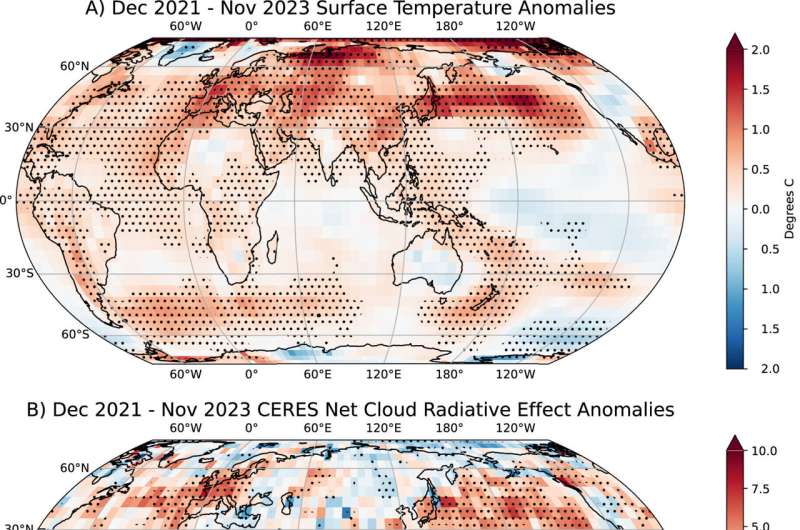This article has been reviewed according to Science X's editorial process and policies. Editors have highlighted the following attributes while ensuring the content's credibility:
fact-checked
peer-reviewed publication
trusted source
proofread
Shipping emissions regulations enacted in 2020 improved air quality but accelerated warming, study finds

Last year marked Earth's warmest year on record. A new study finds that some of 2023's record warmth, nearly 20%, likely came as a result of reduced sulfur emissions from the shipping industry. Much of this warming is concentrated over the northern hemisphere.
The work, led by scientists at the Department of Energy's Pacific Northwest National Laboratory, was published in the journal Geophysical Research Letters.
Regulations put into effect in 2020 by the International Maritime Organization required a roughly 80% reduction in the sulfur content of shipping fuel used globally. That reduction meant fewer sulfur aerosols flowed into Earth's atmosphere.
When ships burn fuel, sulfur dioxide flows into the atmosphere. Energized by sunlight, chemical intermingling in the atmosphere can spur the formation of sulfur aerosols. Sulfur emissions, a form of pollution, can cause acid rain. The change was made to improve air quality around ports.
In addition, water likes to condense on these tiny sulfate particles, ultimately forming linear clouds known as ship tracks, which tend to concentrate along maritime shipping routes. Sulfate can also contribute to forming other clouds after a ship has passed. Because of their brightness, these clouds are uniquely capable of cooling Earth's surface by reflecting sunlight.
The authors used a machine learning approach to scan over a million satellite images and quantify the declining count of ship tracks, estimating a 25 to 50% reduction in visible tracks. Where the cloud count was down, the degree of warming was generally up.
Further work by the authors simulated the effects of the ship aerosols in three climate models and compared the cloud changes to observed cloud and temperature changes since 2020. Roughly half of the potential warming from the shipping emission changes materialized in just four years, according to the new work. In the near future, more warming is likely to follow as the climate response continues unfolding.
Many factors—from oscillating climate patterns to greenhouse gas concentrations—determine global temperature change. The authors note that changes in sulfur emissions aren't the sole contributor to the record warming of 2023. The magnitude of warming is too significant to be attributed to the emissions change alone, according to their findings.
Due to their cooling properties, some aerosols mask a portion of the warming brought by greenhouse gas emissions. Though aerosols can travel great distances and impose a strong effect on Earth's climate, they are much shorter-lived than greenhouse gases.
When atmospheric aerosol concentrations suddenly dwindle, warming can spike. It's difficult, however, to estimate just how much warming may come as a result. Aerosols are one of the most significant sources of uncertainty in climate projections.
"Cleaning up air quality faster than limiting greenhouse gas emissions may be accelerating climate change," said Earth scientist Andrew Gettelman, who led the new work.
"As the world rapidly decarbonizes and dials down all anthropogenic emissions, sulfur included, it will become increasingly important to understand just what the magnitude of the climate response could be. Some changes could come quite quickly."
The work also illustrates that real-world changes in temperature may result from changing ocean clouds, either incidentally with sulfur associated with ship exhaust, or with a deliberate climate intervention by adding aerosols back over the ocean.
But lots of uncertainties remain. Better access to ship position and detailed emissions data, along with modeling that better captures potential feedback from the ocean, could help strengthen our understanding.
In addition to Gettelman, Earth scientist Matthew Christensen is also a PNNL author of the work.
More information: A. Gettelman et al, Has Reducing Ship Emissions Brought Forward Global Warming?, Geophysical Research Letters (2024). DOI: 10.1029/2024GL109077
Journal information: Geophysical Research Letters
Provided by Pacific Northwest National Laboratory





















